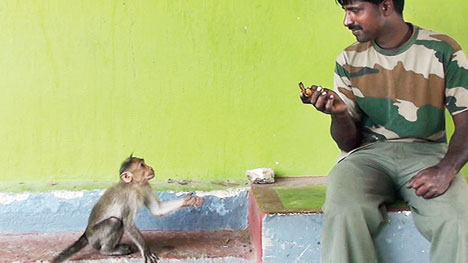
New Delhi: Indian biologists have documented how wild juvenile bonnet macaques use a mix of coo-calls and hand gestures to request food from humans, a "novel behaviour" indicating intentional communication between untrained monkeys and unfamiliar people.
The behaviour appears to have emerged in at least two natural populations of bonnet macaques at Bandipur National Park in Karnataka, the researchers said after four months of observing the monkeys in the wild.
The study is among the first to explore intentional vocal and gestural communication in natural settings between a wild non-ape primate species and humans, the scientists said, reporting their findings in the research journal Scientific Reports.
Their observations suggest that bonnet macaques are capable of intentional communication and that the precursors of such behaviour may be evolutionarily older than previously believed, possibly even preceding similar conduct in apes such as chimpanzees, gorillas or orangutans.
"It is possible that the roots of intentional communication, or language, lie not in the apes but in monkeys," said Anindya Sinha, a primatologist at the National Institute of Advanced Studies, Bangalore, who led the study with two students, Adwait Deshpande and Shreejata Gupta.
Scientists distinguish intentional communication, which is almost always directed at specific recipients and seeks to achieve a goal, from unintentional communication, which may be involuntary - such as an animal yelping in pain or screeching in anger.
Sinha and the students studied two neighbouring populations of bonnet macaques, one with 60 individuals the other with 32, in Bandipur through natural observations as well as field experiments involving interactions between bonnet macaques and people.
The scientists observed 18 juveniles between the ages of two and four years that displayed food-requesting behaviour - coo-calls and hand-extension gestures specifically directed at people - that they say satisfy key criteria for intentional communication.
The bonnet macaques displayed the hand-extension gesture only when interacting with humans and never in any other situation. However, the monkeys also produced the coo-calls when juvenile bonnet macaques were separated from their troops.
"The coo-calls by individuals isolated from the troop are much louder, it is as if they're trying to establish contact with the troop," Sinha said. "But the coo-calls by monkeys seeking food are softer."
Their observations suggest that the mix of coo-calls and hand-extension gestures satisfied key criteria for intentional communication - the monkeys appeared to direct their vocal and visual signals to people with food, persisted with the requests and stopped when they received food.
Similar behaviour has been observed earlier only among apes and monkeys trained in captivity, Sinha said. But wild bonnet macaques in Bandipur appear to have "learnt" to combine coo-calls and extend their palms to request food from humans.
"We believe there is social learning among the juveniles, a cultural tradition, where they learn from each other - also positive reinforcement, which means when something works, the monkey uses that trick again and again," Sinha said.
The study has "systematically documented" behaviour observed among monkeys for years, said Mewa Singh, a senior primatologist at the University of Mysore who was not associated with the Bandipur study. "Intentionally is associated with choice - a decision to communicate to achieve something."
Macaques have long been anecdotally observed employing multiple tactics to wrest food from humans.
"They ambush, they steal, they beg," Singh told The Telegraph. "They may shift from one strategy to another - a monkey may beg from a person holding a bag containing food when there is eye contact, but snatch it away when the person alters gaze."
The Bandipur study supports the idea that language evolved gradually and is not the result of abrupt mutations or changes in early human ancestors, said Deshpande, who is pursuing doctoral studies at the University of Neuchatel in Switzerland.
"We first thought the coo-calls were attention-getters, but it was surprising to see monkeys use the coo-calls even when a person was looking directly at them," Deshpande said. "We speculate that coo-calls might also convey their requests for food."










